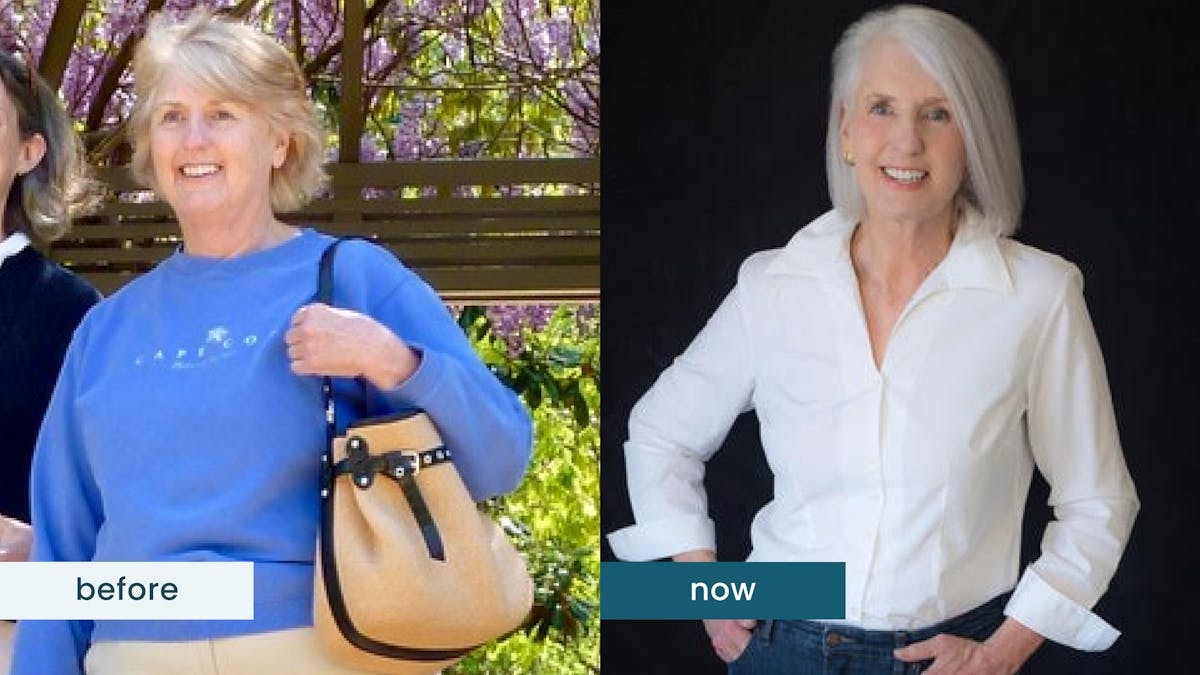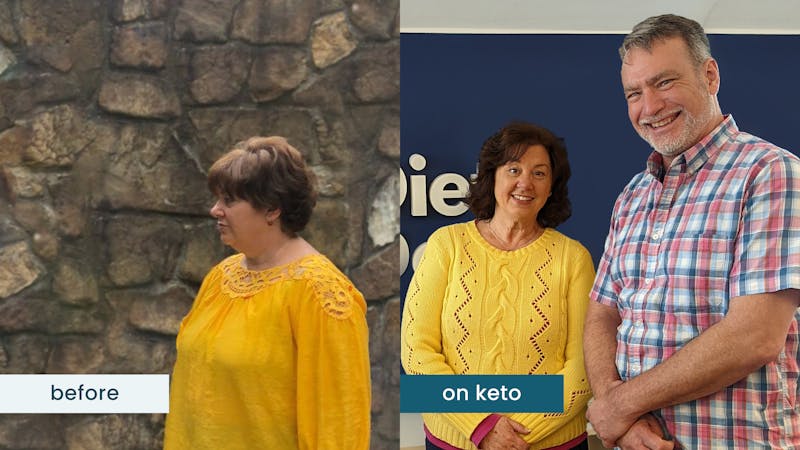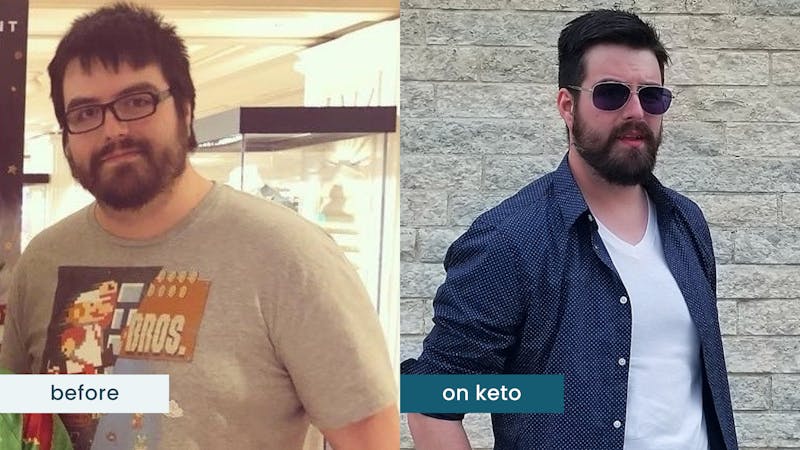How Janet succeeded with more protein and higher satiety

Janet first started a low carb, keto diet in 2010, and it helped her initially lose 60 pounds and improve her health. But after 16 months, she stalled.
She was still above her goal weight and couldn’t seem to budge the scale.
Over the next 10 years, she tried everything while keeping very low carb: “ketoing harder,” longer fasts, one-meal-a-day routines, paleo, and carnivore.
But she not only stayed stalled, she eventually gained back about 20 pounds.
In 2020, she realized strict keto was no longer working for her. She began following Dr. Ted Naiman’s advice to increase protein and decrease excess non-nutritious energy from carbs and fat. She also followed Marty Kendall’s advice on “data-driven fasting” to find the best time for her to eat based on her blood sugar.
Soon, she was prioritizing protein in her two meals and one snack a day, eating lots of fiber-rich vegetables and salad, cutting back on excess fat, and increasing nutritious low-energy carbs later in the day.
Like Dr. Naiman, she calls this “moving the levers” of her diet to find out what works best for her. At age 71, she’s now in the best health and weight of her life.
“Keto or very low carb does not work for everyone. If this sounds like you, consider the new higher-satiety options offered by Diet Doctor,” Janet says.
It certainly worked well for her.
Here is Janet’s story.
What is your name, age and where do you live?
I’m Janet, 71, and I live in the US.
How did you discover low carb?
I’ve known about low carb since the first Atkins book in 1970 and tried it for short periods. In 2010, I read Good Calories, Bad Calories, Primal Blueprint, and New Atkins for a New You. That’s when I finally committed to a low carb diet, 40 years after first hearing about it.
It was August 2010, and I was at my heaviest weight ever, 225 pounds, and I started with the New Atkins Plan.
Did you have any health or weight struggles before going low carb?
Many in my family were heavy, and I was overweight through childhood. As a teen, I slimmed down to a healthy weight and remained so until age 35.
Starting in the mid-1980s, as I approached my 40s, I would gain, lose and regain, but I always stayed overweight, with different versions of the newer low fat, eat-less, move-more advice.
After cancer treatment in 2006, while taking tamoxifen and following recommended “anti-cancer” diet advice, I became obese.
What were you eating before making the change to a low carb diet?
For years, I ate a typical standard diet American diet. Then in 2006, I switched to a diet that was mostly vegetarian, even higher in carbs, with few animal products, more legumes, whole grain bread, pasta, and oatmeal. I continued to gain weight on this plant-based diet.
What happened when you went low carb in 2010?
Following the New Atkins plan and avoiding processed seed oils worked well at first.
After 16 months, my weight had decreased from 225 pounds to 169 pounds, which was just squeaking into a healthy BMI of 25, but I never reached my then-goal weight of 160 pounds.
For the next decade, l would lose weight, then regain it, trying every version of low carb; 20 grams of total carbs, paleo, intermittent and extended fasting, carnivore, etc.
By my 10-year low carb anniversary, I wasn’t feeling my best and finally acknowledged that a very low carb diet was not working for me.
I had already been following Dr. Ted Naiman’s website about protein-to-energy ratios (P:E) and Marty Kendall’s Optimising Nutrition blog for a few years. So for a fresh restart in August 2020, I switched to using the simple infographic guidelines found in Dr. Naiman’s The P:E Diet book.
I also joined Kendall’s Optimising Nutrition data-driven fasting program to find the best time to eat and the Nutrient Optimization Masterclass to find what nutrients my body needed.
Restarting at 188 pounds, I lost 38 pounds in 15 months, 75 pounds in total. I am now at a healthy 150 pounds, which is perfect for me.
So for me, Diet Doctor’s advice to prioritize protein and focus on higher-satiety eating and optimal nutrition has really been what tweaked my success. I applaud Diet Doctor for adding this information to your site.
In what way has your health improved?
When I started low carb, lifelong eczema cleared up and my skin improved. After only three weeks, I had noticeable relief from joint and arthritis pain.
Over the first few years, my vitamin D levels, below normal for years, increased by eliminating processed carbs and seed oils. Food and seasonal allergies were mostly gone, and I haven’t had a cold or virus during this time.
Since 2020, by eating about 50 grams of healthy net carbohydrates with more fiber and lowering the fat, I am now at the weight I was in my 20s; leaner, with more energy and better digestion. Nagging minor “low thyroid” symptoms are gone; my hair is thicker, my nails stronger, my dry skin improved, and I no longer feel cold.
My blood glucose and HbA1c are back to normal, and I have regained metabolic flexibility. My oncologist supports my low carb, paleo eating style since he sees benefits in my annual blood work and scans.
At 71, I take no medications, and by optimizing micronutrient intake with more nutrient-dense food choices, only a few supplements.
What does a typical day of eating and/or fasting look like for you now?
Using the Data-Driven Fasting program to determine when to eat based on my blood glucose levels, I now usually eat two meals and a snack between 11 am and 6 pm.
When I used OMAD (one meal a day) in the past, I would become too hungry and overeat nutrient-poor choices. Longer is not better with fasting, especially if you are older like me. We need more protein and minerals for bone health and strength, and that is hard to get in just one meal.
I don’t often track food or test blood glucose anymore, but I do eat fewer calories with more nutrient-dense foods than I did with one higher fat meal.
I awake early and start the day with coffee and ultra-filtered milk.
My first meal is around 11 am and has 50+ grams of protein, with more nutrient-dense seafood and lean meat than before and plenty of high fiber vegetables in a big stir-fry or salad. Or, I might eat a two-whole-eggs-plus-egg-white scramble with seafood and vegetables.
My tip is that adding 4 to 6 ounces of egg whites to two eggs and some canned fish or leftover chicken is one easy way to prioritize protein at the first meal. I have simple salads, stir-fries, protein shakes, and low-fat yogurt; it is embarrassing to even call these “recipes.”
Dinner also includes protein and high fiber vegetables but with more carbs, such as carrots, sugar snap peas, green beans, or hummus. I may even add more fruits, even frozen banana slices to a protein smoothie. My sleep is better with more carbs later in the day.
I may even from time to time have some local, artisan sourdough bread — I am not sensitive to gluten. It is freeing to have metabolic flexibility, being able to switch fuel sources between carbs and fat.
Added fats and oils are limited, but my intake of omega-3 fats has increased with more seafood.
Cheese is a special occasion treat but no longer a regular ingredient in recipes. Rather than pepperoni, cheese, pork rinds, or a low carb, high fat recipe, my mid-afternoon snack may be crunchy vegetables like sugar snap peas or carrots with hummus or salsa, protein ice cream, cottage cheese, or a protein flan.
Liver paté, or a low fat fermented yogurt with protein powder, is an enjoyable snack that adds protein, calcium, selenium, and Vitamin A . Whole foods are preferred, but some dairy with protein powder helped me reach my goals. My protein goal is 1 gram of protein per pound of ideal body weight based on my height of 5’9”, or 145 grams of protein a day. Any increase in protein percentage is helpful to improve satiety.
What mistakes have you learned on your journey?
My decade-long mistake is what Dr. Naiman describes as a “unifocal over-reliance on carb reduction.”
As an older woman with a history of obesity, when my weight loss stalled, I should have pulled other “diet levers.” Those levers are prioritizing protein, reducing added fat, fatty foods, and total energy, and adding fiber, micronutrient-rich vegetables, whole food carbs, fermented foods, and daily time-restricted eating.
The vegetables, fruits, and dairy I had previously avoided when trying to “keto harder” were key to both increasing nutrient density and satiety per calorie. “Nutrient density is the icing on the cake of satiety and optimal nutrition. However, adequate protein without excess energy (from fat and carbs) is the cake,” says Marty Kendall in Optimising Nutrition.
Do you think exercise is necessary for success on low carb?
I think exercise is necessary for maintaining muscle and bone strength, not weight loss. Losing 75 pounds only through diet when in your 70s would not have been a good look.
I do some strength training and early morning walks, and in summer, I exercise in a pool almost every day. One “habit pairing” tip I’ve enjoyed these past 12 years is to learn about nutrition and exercise while walking. My podcast library is always changing; two current favorite subscriptions are the Diet Doctor podcast and Optimising Nutrition.
Do you have any favorite Diet Doctor recipes, resources, or programs?
After seeing Dr. Eenfeldt’s 2011 talk at the Ancestral Health conference, I have followed Diet Doctor’s English website and supported Diet Doctor’s mission ever since membership became an option.
I appreciate all the well-organized, high-quality content offered by the Diet Doctor team. The evidence-based health guides have been one of my favorite parts of the site, a trusted resource for sharing clearly written low carb nutrition information with social media groups and friends.
Now that Diet Doctor has new guides on making a low carb diet higher protein and higher satiety, these resources are new favorites. Two articles have been particularly helpful, How and why to eat higher protein and Top 10 tasty ways to eat more protein and less fat.
I still carry printed copies of the beginner low carb leaflet to share with anyone who asks about my weight loss and I have added the P:E calculator graphic with it. I also share video presentations, success stories, and Dr. Scher’s five-star interview podcast episodes.
What are your top three tips for people starting low carb?
- Don’t be afraid of protein or fiber from vegetables. Prioritize protein at every meal and eat plenty of nutrient-dense, high fiber vegetables and berries with your protein to overcome initial carb and sugar cravings. As Dr. Ted Naiman advises, unless you need a therapeutic ketogenic diet, “Do not ‘go on a diet.’ Start eating now, the way you are going to eat forever.”
- Use Diet Doctor’s food graphics or the newer protein percentage and satiety per calorie charts. Low-fat Greek yogurt, along with other dairy like cottage cheese and whey protein, has high P:E ratios, with beneficial micronutrients to increase satiety.
- Using a food tracker is not necessary to start, but if stalled, check that you are getting enough protein but not overeating energy. Ground beef, cheese, nuts, and pork rinds may have more calories and less protein than you realize.
Final thoughts?
Over my 12-year weight loss journey, a very low carb diet took me halfway to my goal, improving my health and keeping weight regain partially in check.
I stayed strict low carb, avoided grains, sugar, and seed oils, but was not close to my ultimate weight and health goals and, over time, regained 20 pounds.
“Keto,” or very low carb, does not work for everyone. If this sounds like you, consider the new options offered by Diet Doctor. By increasing protein, fiber, and whole, nutrient-dense carbs, “pulling all the other diet levers,” I am now maintaining an ideal weight and in the best health of my life.
Many thanks to the Diet Doctor team, Dr. Ted Naiman, and Marty Kendall for all the awesome work you do helping people around the world optimize their health.
Thanks for the inspiring story, Janet. Your low carb journey, learning how to optimize protein, fiber and satiety per calorie will help many people learn how to experiment and “pull the levers” of these elements in their diet to help maximize their health and results.
~ Anne Mullens
Share your story
Want to share YOUR success story with Diet Doctor? Send an email to success@dietdoctor.com. Feel free to use the questions on this page as a starting point.
Share your story

